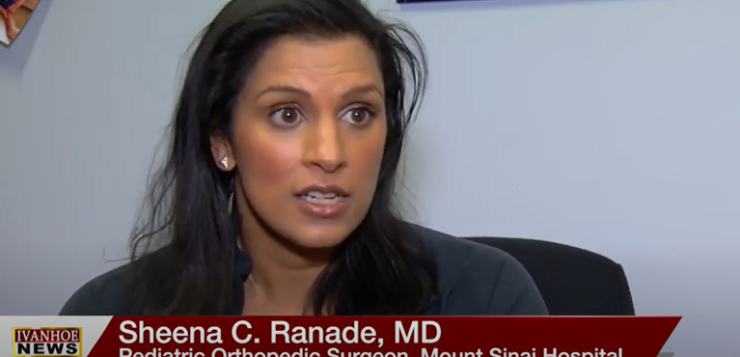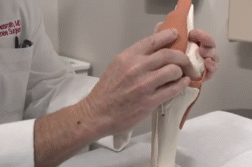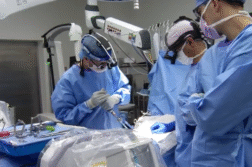Sheena Ranade, M.D., Assistant professor of Orthopedic Surgery at Mount Sinai Hospital, talks about a surgery called SUPERknee, and how it can create stability in the legs of kids that have a condition known as Fibular Hemimelia.
Interview conducted by Ivanhoe Broadcast News in November 2021.
Can you describe what the SUPERknee procedure is?
Dr. Ranade: In children that have a congenital issue that affects the ligamental stability of the knee, there is a sort of overarching title for a couple of different procedures that can all be done in conjunction with one another in order to restore stability to the knee. The key to it is that you have to have an intact extensor, which is the quad muscle attaching through the kneecap to the tibia. So, if that is present, then we can make everything else out of their own existing tissues, which is pretty cool.
Why do they call it the SUPERknee?
Dr. Ranade: The surgeon who designed it is really good at marketing. He’s a very clever man and it’s a cool name. There’s a SUPERankle and a SUPERhip all designed by the same surgeon.
Could you describe what the condition is that Layla had?
Dr. Ranade: She has fibula hemimelia. What that is, is an issue in utero where the patterning of the outer part of the leg, lower leg and the foot is not fully complete. Sometimes what happens is they have a relatively normal ankle, but the upper part of the fibula is not present. And in Layla’s case, it was much more significant. But she had all of the lateral or the outer part of her foot. So sometimes kids only have three toes or two toes as a result of it. And in that situation, really, there’s not a ton of reconstructive work that can be done. But in Layla’s case, you had a complete foot. So the sky was kind of the limit. So we, my partner, Dr. Allen, and I have taken care of her for years and years and years. Her parents really raised her to the point where she was mature enough that we could start treating it. And she’s a really awesome kid.
How was it diagnosed then and how early was it diagnosed?
Dr. Ranade: She was diagnosed pretty soon after birth. The positioning of the foot was abnormal. When there’s no fibula, which is the outer bone of the ankle, what happens is the foot can then sort of move off to the side. She had this shortened leg that was short compared to the other side and her foot was malpositioned.
When doctors saw that, what were the options that for treatment at the time?
Dr. Ranade: Options are very patient specific. Patient specific includes social situation and the ability of parents to really support and enable kids to be as successful as they can be and Layla really on the parents’ side hit the jackpot. She has amazing parents who wanted to do everything they could do to give her the most typical childhood that she could possibly have. There was a pretty frank discussion about amputation versus understanding that she may need several surgeries in the future. The benefit of an amputation in that setting, even though it sounds awful, is that it’s a one, maybe a couple of smaller procedures to revise the stump if there’s any issue kind of deal, whereas what Layla has gone through to date and will continue to go through is substantially more time consuming for the parents, difficult for Layla. There’s a lot of considerations that go into the decision making.
Can you walk us through what you and your partners had to do to reconstruct Layla’s leg?
Dr. Ranade: This has really been a team effort. My partner, Dr. Allen, and she’s also a pediatric orthopedist. She and I first lengthened Layla’s tibia. The process for this is something called distraction osteogenesis. Doctors love words that are big because then we sound smart, and it helps our patients trust us. We place the circular frame using pins and attach it to the leg. We break the bone and at a very controlled rate stretch – a millimeter a day is what the bone will tolerate and heal. It’s a laborious, very slow process. She’s not allowed to put any weight on the leg while you’re lengthening. It’s hard for the parents. It’s hard for the kid. She swam through it. We’ve placed many, many frames. And they say that getting something called a pin site infection, because there’s lots of little pins holding the frame, is a 100 percent complication rate for this particular procedure. And Layla had none. Her parents did a phenomenal job keeping it clean, making sure that her lengthenings were always perfect because she also had a little bit of an angle to her tibia that we corrected. Follow ups for consistently miraculous. I mean, it was something.
How long was that surgery and how complicated a surgery is that to do?
Dr. Ranade: It sounds so complicated. Some kids need also patella work. She didn’t need any of that. But it took about three and a half hours. It wasn’t super long. I think part of that is also being super prepared and knowing exactly what you need to do. The other benefit is having a fully trained fellowship-trained surgeon by your side makes everything go smoother. When there’s two of us, it’s always a little bit nicer. But it’s very complicated in the sense that you really need to know your anatomy, understand the structures you’re reconstructing and make sure that your decision making in where you place sort of the constraint points of the two ligaments is correct and will give her the best final outcome. The procedure itself is surprisingly straightforward.
What are you maneuvering in her leg to do this procedure?
Dr. Ranade: It’s taking the IT band, which is sort of the thickening of fascia on the outer side of the thigh and rerouting it. And then you also are routing it through the knee and then in front of the knee.
Is this something that works better for pediatric patients?
Dr. Ranade: This is a pediatric procedure, primarily.
Why would this be better for kids than for adults?
Dr. Ranade: This is a what we call physeal sparing procedure. The physis is the growth plate. In our little pediatric orthopedic community, the growth plate is king. We try our very hardest in a child who has substantial growth left and in a child like Layla where what little growth she has we need every tiny bit on that tibia and every tiny bit on that femur to be very careful to not impact the growth plates. For her in particular, but in general and pediatric orthopedics, we very much respect the physis. We do not bother it unless we absolutely have to. And this is an extra physeal – so meaning outside of the growth plate reconstruction.
Can you describe the recovery process?
Dr. Ranade: It’s healing and therapy primarily. In Layla, it’s healing like unbelievably well. Her incision is pretty substantial. It goes all the way across the knee, up to the mid-thigh. At week one, we both were just completely taken aback at how beautifully she was healing already. And for Layla the hardest part of the recovery has been telling her she can’t do things yet.
What’s Layla’s outlook then? Will she have normal function as she gets older?
Dr. Ranade: She’s still substantially shorter. At the time that we did the lengthening, Dr. Allen and I did the lengthening, we did something called growth modulation or epiphysiodesis which is where you basically give a bear hug to the growth plate. You don’t touch it. But you put little plates above and below which prevent it from lengthening. So on the opposite side, on her long side, we put little bear hug plates on either side of the growth plate on the tibia and then also on the femur. She’s not growing on the one side. We’re lengthening the other side. And then we are going to try to get about two centimeters or three centimeters of shortening on that side so that she only needs one more lengthening procedure as opposed to needing two more.
What’s the impact for patients like Layla and others who have this procedure?
Dr. Ranade: Patient selection for this kind of procedure is, the most important part. Technical skill is important. But honestly, picking the right patient, the patient with the social situation that can tolerate this the mental fortitude, the maturity to comply, even though it’s incredibly frustrating to do so, I think that is the key to a successful surgery in this particular sphere. Because if you have a kiddo whose parents aren’t helping them enough with the pin site cleaning or who don’t have the social support to really help boost their spirits through this process, you’re in a wheelchair using a walker for three months. It’s hard. Actually, we had a little sort of a secret weapon in this in that her parents got her Macy her dog for Christmas, which is sort of in the middle of this whole process. And Macy has been such a help for her recovery both from the lengthening and also from the SUPERknee.
In what ways has Macy been helping in Layla’s recovery?
Dr. Ranade: She definitely makes Layla get out and do stuff. She’s a very demanding dog. She often joins the visits on face time with dad in the car. But she’s very much lifted her spirits. I think that’s the number one contributor. But she’s also kept her, you know, busy giving her tasks to do, taking care of the dog, etc. so that she’s not just alone at home going through this whole process.
What kind of an impact will this surgery have for her down the road? What will she be able to do now that she might not have been able to do with an amputation?
Dr. Ranade: With an amputation, she would have pretty similar function, but she would need to use a prosthetic. Prosthetics in pediatric population often have to be changed very frequently. And children have this phenomenon of overgrowth where the end of the bone has little spikes that develop. Then you have to have serial surgery to remove them. There are pressure issues and other things that come with using a prosthetic and function isn’t quite equivalent. It’s a little bit diminished.
How does she get around?
Dr. Ranade: Even before the initial lengthening, she was doing cartwheels in my office. I think that for Layla, she just will find a way. That being said, she has a shoe lift and a small lift that’s on her AFO and she can get her foot down to the ground. She does that slightly by tilting her pelvis to get closer. But that means that she can get her foot flat, which means she’s running now, which is pretty cool to see.
What is an AFO?
Dr. Ranade: An AFO is an ankle foot orthotic. It’s a special brace that we use in kiddos to help support the lengthening that we did at that time of initial surgery. And for her, her ankle is not a typical ankle because she doesn’t have the fibula. What it does is it gives her some stability.
Is there anything I didn’t ask you, Doctor, about this procedure, about Layla and her family that you would want people to know?
Dr. Ranade: It’s neat to see the X-rays. It’s kind of neat to look at, the change from one point to another. This is still an ongoing process. Layla, her knee is slightly what we call knock-kneed on the affected side. She’s going to need to have that. At the next surgery. She’s going to still need the lengthening of her tibia. But honestly, there’s nothing stopping her. She’s super impressive. I guess the only other thing I would say is that it’s a privilege to take care of children. But there are certain families that make you want to be a better parent yourself, and Layla’s family is one of those.
How rare is the condition?
Dr. Ranade: I think it’s one in 40,000.
END OF INTERVIEW
This information is intended for additional research purposes only. It is not to be used as a prescription or advice from Ivanhoe Broadcast News, Inc. or any medical professional interviewed. Ivanhoe Broadcast News, Inc. assumes no responsibility for the depth or accuracy of physician statements. Procedures or medicines apply to different people and medical factors; always consult your physician on medical matters.
If you would like more information, please contact:
Stacy Anderson
Sign up for a free weekly e-mail on Medical Breakthroughs called First to Know by clicking here




